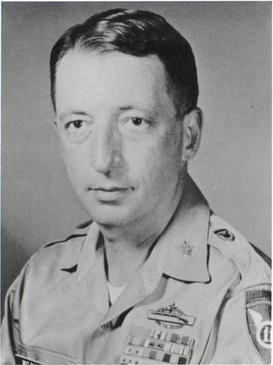Years of service 1942-1975 | Name Robert McDade | |
 | ||
Place of burial Oakland Cemetery, Sag Harbor, NY Allegiance United States of America Battles/wars World War IIKorean WarVietnam WarBattle of Ia Drang Similar People Hal Moore, Nguyen Huu An, George Stephen Morrison, Basil L Plumley, Chae Myung‑shin | ||
Robert Alexander McDade (August 11, 1922 - October 14, 2009) was a United States Army colonel. He is best known as the Lieutenant colonel in command of the 2nd Battalion, 7th Cavalry Regiment at the Battle of la Drang in 1965, during the Vietnam War.
Contents
Military career
McDade was one of relatively few officers to serve with an infantry unit in three wars — the South Pacific in World War II where he commanded a rifle platoon, the Korean War where he commanded a rifle company, and the Vietnam War where he commanded an infantry battalion. He was wounded in action (WIA) four times. Besides his combat assignments, Mcdade held military posts in Washington, D.C., New York City, Germany and Panama.
Battle of Ia Drang
The Battle of la Drang was the first major battle between the United States Army and the People's Army of Vietnam (PAVN), referred to by U.S. fighting units as the North Vietnamese Army (NVA), during the Vietnam War. The two-part battle began on November 14, 1965 and was focused on landing zone (LZ) X-Ray. This part of the battle was fought primarily by the 1st Battalion, 7th Cavalry Regiment (1/7) of the 1st Cavalry Division (Airmobile), led by Lt. Colonel Hal Moore, although elements of Alpha and Bravo Companies of the 2nd Battalion, 7th Cavalry (2/7) participated. The rest of the 2/7 arrived by the morning of November 16.
Only three weeks before the battle, Lt. Col. McDade had been the 1st Cavalry Division's personnel officer, and had not commanded troops in ten years. His orders were to march 2/7 to another landing zone, LZ Albany, 4 kilometers to the north-northeast. On the march, through high grass and thick vegetation, McDade declined an offer of artillery assistance from the 2nd Battalion, 5th Cavalry Regiment (2/5), and allowed the middle ranks of soldiers to march single file with little regard for security. On breaks, exhausted soldiers sprawled on the grass
At midday, two NVA soldiers were captured. Lt. Col. McDade moved forward to interrogate the prisoners himself, and called his company commanders forward for a conference. Most were accompanied by their radio operators. The American column was halted in unprepared, open terrain, and strung out in 550-yard (500 m) line of march. Meanwhile, The NVA troops were organizing an assault.
The NVA opened fire, and Charlie Company took the worst of it, losing 20 killed and many more wounded in the first minute. The lead unit, Alpha Company, lost two platoons, 50 men, in the first minutes. The North Vietnamese were in among the Americans and up in the trees, so American artillery fire killed men from both sides. The commander of the 1st Cavalry Division, General Harry W.O. Kinnard and his second-in-command, Brig. Gen. Richard Knowles, later said the brigade commander, Colonel Brown, had not alerted them. Brown said he could get no coherent report from McDade. "We had ample resources at hand to reinforce Albany–Hal Moore's men would have gone in a minute–but no one asked," says General Kinnard.
Reinforcements arrived in the late afternoon and evening, and wounded were evacuated late in the evening, and the battle was over. The casualty toll for the 2nd Battalion, 7th Cavalry was 155 killed, 125 wounded and at least four men missing in action. The battle lasted 16 hours. McDade would continue to lead the 2nd Battalion, 7th Cavalry until March 1966.
Family
McDade met his wife, Elinor Van Ingen, in Saigon, where she was working for the State Department. They married in 1974. The McDades owned and managed The Goat Alley Gallery in Sag Harbor for twenty three years.
Military awards
McDade's decorations and awards include:
